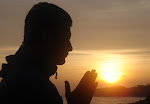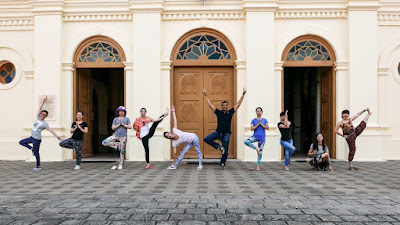Longing to practice off the mat at the birthplace of yoga, called for my 3rd visit to India with Master Deva & Dileep. Challenge on patience started 2 weeks before embarking with an experimental failure of e-visa to foggy application of regular visa at the Indian consulate agency. Athena and I were granted visas within 2 days of departure, feeling ready to dissolve the stress in Kerala.
A team of 15 safely landed in Cochin airport after a long 2-stage flight feeling tired but excited, whereas Geoffrey’s snacks got left behind in Cochin e-visa customs awaiting area when he reached out to Indian immigration to speed up the e-visa processing. We then discovered that Athena’s luggage was left in Singapore and she spent couple of days anticipating arrival of her luggage. A disco-style coach bus took us to Deshadan Backwater Resort but almost everyone had a nap rather than dancing and this rounded up our first day.
A 45-minute silent walk kicked off the practice on day 2 after breakfast. Disconnection from external world opened the window for retrospective self-study, turned the mind from watching to feeling mode, allowed emotions to be observed and created spaces for self-care & gratefulness for following footsteps of our Master. Deva led part 2 of morning indoor learning, challenged our body with asana including silent Surya Namaskar, partner work, forming and passing through yoga tunnels which reminded us on remaining a positive attitude towards up and downs in life and we filled the session with lots of fun and laughers. Geoffrey’s knee injury instantly tested me to apply the skills just did but buddies’ concern really loosened the tension in my heart. Short walk outside the resort after lunch brought us to appreciate boatmen doing life basics and with visits to households and Shiva temple nearby exposed us to Kerala’s local life. Pool side yoga in afternoon was a stretchy tutorial and each member led a warm up pose followed by a new understanding of trust with a closed-eye walk in a straight line individually and then as a horizontal group to exercise our mindfulness and trust. Night visit to a Vishnu temple festival finished our day.
Dileep led the 0630 hours class on day 3. After absorption of surya energy from couple sets of sun salutations, we explored a Hatha style session with ceiling of infinity sky instead of limited suffocating ceiling. We spent the rest of the day sightseeing, visits to fa Krishna temple and a snake temple, where a few of us experienced a 2-min pranayama in a cool corner of the
temple. Tourist activities took longer than expected and our lunch became dinner in early evening at a beach side restaurant where we had planned for beach yoga for afternoon; however, we missed the bright orange sunset when heavy storm with rain and lighting called off the sunset learning. Sunrise class on day 4 with twist and stretch theme was given by Deva beside the pool and highlighted our pratyahara practice with a blind closed eye dance. Switching off our visual consciousness revealed to us the compensatory ability of our bodies to respond more sensitively to our other body senses which we might not always be aware of. Then we headed to a boathouse trip and soaked in the beauty of Kerala backwater view, Indian lunch & coconut, music, photo and video shoots of members’ with sounds of Kerala backwater scenery. Thanks to DJ, reporter cum video creator Geoffrey, we have a visual record to appreciate and share. We ended the day with practice that turned into to a shopping time at a local supermarket and again assessed our mindfulness to deal with local culture and community. Dileep’s pool side teaching on day 5 morning taught me that I am still working towards that level of asana followed by off mat experience of being divided into 2 teams, namely sightseeing and shopping team led by Deva while Ayurveda massage team led by Dileep and I joined massage team. Unlike Thai or Chinese massage, Ayurveda massage is another brand new enjoyment which was delivered in a more homey way and less scary than imagined, but the experience of a dry powder massage is something to feel, with the ritual being of something surreal but satisfying. We did not plan to meet up with the shopping team due to heavy traffic towards end of the work day; instead, we visited a musical instrument shop and bought a modern Mridangam and then returned to relax at the resort, where we noticed 2 additional rabbits so we enjoyed watching them. Evening workout with quality chats after reunion of sightseeing team called it the day, where we learned of the adventures of the shopping team which struggled with the driver who wanted to take them to shopping centres and life in the tourist sector can often remind us to know our own destiny rather than be led blindly. Last sunrise practice on day 6 was a co-teach class delivered by Deva and Dileep at 0630 hours, facing the far island and fishermen. We adventured with a light asana session followed by chanting, instruments supported by Deva, Dileep Joyce and Geoffrey. We were grateful to receive joyful resonance from Hare Krishna Hare Rama and Gayatri mantra to conclude our study time in Kerala. We spent 2 hours in a city mall mentally prepared our way back to city
life, headed back home with exercised body and refreshed mind & soul charged by mother nature. Thanks to Deshadan resort crew who took very good care of us, especially chef Prayag for adjusting our meals. I am content about what yoga has brought me to and I will always remember to share what I have learnt from yoga. It would not be a jovial experience without Master Deva, Master Dileep and every single member in Team 15.
May all of us be healthy, happy and free. Namaste!
Lisa Yeung
A team of 15 safely landed in Cochin airport after a long 2-stage flight feeling tired but excited, whereas Geoffrey’s snacks got left behind in Cochin e-visa customs awaiting area when he reached out to Indian immigration to speed up the e-visa processing. We then discovered that Athena’s luggage was left in Singapore and she spent couple of days anticipating arrival of her luggage. A disco-style coach bus took us to Deshadan Backwater Resort but almost everyone had a nap rather than dancing and this rounded up our first day.
A 45-minute silent walk kicked off the practice on day 2 after breakfast. Disconnection from external world opened the window for retrospective self-study, turned the mind from watching to feeling mode, allowed emotions to be observed and created spaces for self-care & gratefulness for following footsteps of our Master. Deva led part 2 of morning indoor learning, challenged our body with asana including silent Surya Namaskar, partner work, forming and passing through yoga tunnels which reminded us on remaining a positive attitude towards up and downs in life and we filled the session with lots of fun and laughers. Geoffrey’s knee injury instantly tested me to apply the skills just did but buddies’ concern really loosened the tension in my heart. Short walk outside the resort after lunch brought us to appreciate boatmen doing life basics and with visits to households and Shiva temple nearby exposed us to Kerala’s local life. Pool side yoga in afternoon was a stretchy tutorial and each member led a warm up pose followed by a new understanding of trust with a closed-eye walk in a straight line individually and then as a horizontal group to exercise our mindfulness and trust. Night visit to a Vishnu temple festival finished our day.
Dileep led the 0630 hours class on day 3. After absorption of surya energy from couple sets of sun salutations, we explored a Hatha style session with ceiling of infinity sky instead of limited suffocating ceiling. We spent the rest of the day sightseeing, visits to fa Krishna temple and a snake temple, where a few of us experienced a 2-min pranayama in a cool corner of the
temple. Tourist activities took longer than expected and our lunch became dinner in early evening at a beach side restaurant where we had planned for beach yoga for afternoon; however, we missed the bright orange sunset when heavy storm with rain and lighting called off the sunset learning. Sunrise class on day 4 with twist and stretch theme was given by Deva beside the pool and highlighted our pratyahara practice with a blind closed eye dance. Switching off our visual consciousness revealed to us the compensatory ability of our bodies to respond more sensitively to our other body senses which we might not always be aware of. Then we headed to a boathouse trip and soaked in the beauty of Kerala backwater view, Indian lunch & coconut, music, photo and video shoots of members’ with sounds of Kerala backwater scenery. Thanks to DJ, reporter cum video creator Geoffrey, we have a visual record to appreciate and share. We ended the day with practice that turned into to a shopping time at a local supermarket and again assessed our mindfulness to deal with local culture and community. Dileep’s pool side teaching on day 5 morning taught me that I am still working towards that level of asana followed by off mat experience of being divided into 2 teams, namely sightseeing and shopping team led by Deva while Ayurveda massage team led by Dileep and I joined massage team. Unlike Thai or Chinese massage, Ayurveda massage is another brand new enjoyment which was delivered in a more homey way and less scary than imagined, but the experience of a dry powder massage is something to feel, with the ritual being of something surreal but satisfying. We did not plan to meet up with the shopping team due to heavy traffic towards end of the work day; instead, we visited a musical instrument shop and bought a modern Mridangam and then returned to relax at the resort, where we noticed 2 additional rabbits so we enjoyed watching them. Evening workout with quality chats after reunion of sightseeing team called it the day, where we learned of the adventures of the shopping team which struggled with the driver who wanted to take them to shopping centres and life in the tourist sector can often remind us to know our own destiny rather than be led blindly. Last sunrise practice on day 6 was a co-teach class delivered by Deva and Dileep at 0630 hours, facing the far island and fishermen. We adventured with a light asana session followed by chanting, instruments supported by Deva, Dileep Joyce and Geoffrey. We were grateful to receive joyful resonance from Hare Krishna Hare Rama and Gayatri mantra to conclude our study time in Kerala. We spent 2 hours in a city mall mentally prepared our way back to city
life, headed back home with exercised body and refreshed mind & soul charged by mother nature. Thanks to Deshadan resort crew who took very good care of us, especially chef Prayag for adjusting our meals. I am content about what yoga has brought me to and I will always remember to share what I have learnt from yoga. It would not be a jovial experience without Master Deva, Master Dileep and every single member in Team 15.
May all of us be healthy, happy and free. Namaste!
Lisa Yeung














